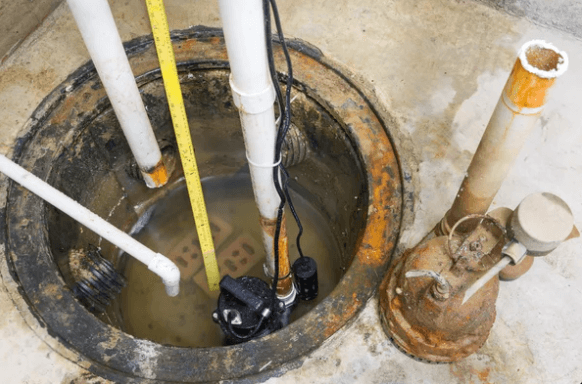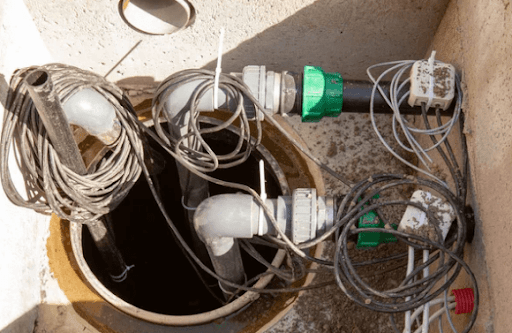 Last updated: July 30th, 2024
Last updated: July 30th, 2024
Tips For Sump Pump Maintenance & Troubleshooting Common Issues

Sump pumps are vital for preventing basement flooding by removing excess water that accumulates due to groundwater or heavy rainfall. However, like any mechanical device, sump pumps require regular maintenance and can encounter various issues. This guide provides detailed information on sump pump maintenance & troubleshooting common issues.
Preventative Maintenance of Sump Pump: Safeguarding Your Basement
Sump pumps protect your basement from flooding by removing excess groundwater or rainwater. Regular maintenance ensures optimal performance and prevents costly repairs or basement flooding during critical times.

Here’s a detailed guide to preventative sump pump maintenance:
Maintenance Frequency
- Visual Inspection: Conduct a visual inspection every 3 months.
- Cleaning: Clean the sump pit and pump components annually.
- Professional Maintenance: Consider professional inspections every 2-3 years.
Visual Inspection
- Power Source: Ensure the electrical connection is secure, the cord is undamaged, and the outlet functions properly.
- Sump Pit: Check for debris like leaves, dirt, or sediment that can clog the pump.
- Pump Condition: Inspect the pump for signs of rust, corrosion, or cracks in the housing.
- Float Switch: Verify the float switch moves freely and isn’t stuck in any position.
- Discharge Line: Ensure the discharge line is clear of obstructions and the end is not submerged in water, preventing proper drainage.
Cleaning The Sump Pump
- Disconnect Power: Always unplug the pump before performing any cleaning tasks.
- Sump Pit: Remove debris from the sump pit using a bucket or shop vac.
- Intake Screen: Clean the intake screen to prevent clogging that can restrict water flow.
- Pump Impeller: For submersible pumps, remove the pump and clean the impeller carefully to remove any debris that might hinder water flow.
- Discharge Line: Check for blockages in the discharge line and clear them if necessary.
Additional Details For The Sump Pump Maintenance
- Pump Type: Familiarize yourself with your specific sump pump type (submersible vs. pedestal), as maintenance procedures might differ slightly.
- Horsepower Rating: The pump’s horsepower rating should be suitable for your basement size and expected water flow. Consult your pump manual or a professional for guidance.
- Discharge Line Diameter: Ensure the discharge line diameter is sufficient to handle the pump’s capacity. Common diameters are 1-1/4″ or 1-1/2″.
- Check Valve: Inspect the check valve for proper operation. A faulty check valve can allow water to backflow into the sump pit, causing the pump to cycle repeatedly.
- Battery Backup: Install a battery-powered backup sump pump to ensure operation during power outages.
- Water Alarm: Install a water alarm in your basement to alert you of potential flooding, especially if the sump pump fails.
- Maintenance Records: Keep a log of maintenance activities, including cleaning dates and any repairs performed.
Common Sump Pump Issues & How To Fix Them
Sump pumps prevent basement flooding by removing excess water accumulating in the sump pit. However, like any mechanical device, sump pumps can encounter various issues that compromise functionality. Here’s a breakdown of some common problems and their technical details:
1. Overwhelmed Sump Pump

An overwhelmed sump pump occurs when the pump cannot keep up with the rate of water entering the sump pit. This can lead to a flooded basement, a potentially devastating situation. Here’s a breakdown of the causes, consequences, and solutions for an overwhelmed sump pump:
Causes
- Insufficient Pump Capacity: The most common cause is an undersized sump pump. The pump’s horsepower rating should suit your basement size and expected water flow.
- Heavy Rainfall/Water Influx: Excessive rainfall or high water table levels can overwhelm a properly sized pump.
- Clogged Discharge Line: A clogged discharge line prevents water from being pumped out, causing the pit to fill faster than the pump can handle.
- Stuck Float Switch: A malfunctioning float switch can prevent the pump from activating, even with rising water levels.
- Power Outage: The sump pump cannot function without power, leaving your basement vulnerable to flooding.
Consequences
- Basement Flooding: This is the most significant consequence, potentially causing water damage to your property and belongings.
- Pump Damage: Overworked pumps can overheat and fail, leading to costly repairs or replacements.
- Mold and Mildew Growth: Standing water creates a breeding ground for mold and mildew, which can pose health risks and further damage to your basement.
Solutions
- Upgrade Pump Capacity: If your pump is undersized, consider installing a more powerful model with a higher horsepower rating.
- Install a Backup Pump: A battery-powered backup pump ensures continued operation during power outages.
- Maintain Discharge Line: Regularly clean the discharge line to prevent clogs and ensure proper water flow.
- Inspect Float Switch: Ensure the float switch moves freely and activates correctly with rising water levels.
- Invest in a Water Alarm: Install a water alarm in your basement to alert you of potential flooding, especially if the sump pump fails.
- Consider a Secondary Sump Pump: In areas with high water tables or frequent heavy rainfall, installing a secondary sump pump can provide additional protection.
2. No Water In The Sump Pit

While a dry sump pit might seem good initially, it can sometimes indicate potential problems with your sump pump system or the surrounding drainage network. Here’s a breakdown of the reasons why you might not have water in your sump pit and the solutions you can explore:
Normal Scenarios
- Low Water Table: If the water table in your area is naturally low, especially during dry seasons, there might not be enough water to enter the drainage system and reach the sump pit. This is generally not a cause for concern.
- Effective Drainage System: A well-functioning drainage system around your foundation might efficiently divert water away from your basement, preventing it from accumulating in the sump pit.
Potential Issues
- Clogged Drain Tile: The drain tile network that collects water around your foundation and channels it to the sump pit can become clogged with debris, soil, or tree roots. This blockage prevents water from reaching the pit.
- Solution: Contact a professional plumber to inspect and clean the drain tile system using specialized equipment, such as a drain snake or hydro jetting.
- Improperly Installed Drain Tile: If the drain tile is not installed at the correct slope or is positioned too far away from the foundation, it might not effectively collect groundwater.
- Solution: This requires professional assessment and potential reinstallation of the drain tile system to ensure proper water collection.
- Frozen Discharge Line: During cold weather, the discharge pipe that carries water away from the sump pump can freeze, preventing water from being pumped out. This can lead to a backup of water in the pit.
- Solution: Insulate the exposed portion of the discharge line or install heat tape to prevent freezing.
- Faulty Check Valve: A malfunctioning check valve within the discharge line allows water to flow back into the sump pit after being pumped out. This creates a cycle where the pump constantly runs but never removes all the water.
- Solution: Replace the faulty check valve with a new one to ensure proper water flow direction.
- Stuck Float Switch: The float switch in the sump pit triggers the pump to activate when the water level reaches a certain point. If the switch is stuck in the “off” position due to debris or malfunction, the pump won’t turn on even if water is present.
- Solution: Inspect the float switch for any obstructions or damage. Gently move it up and down to ensure free movement and clean any debris hindering its operation.
3. Clogged Sump Pump Or Switches

A clogged sump pump or malfunctioning switch can be a homeowner’s worst nightmare, potentially leading to basement flooding. Here’s a detailed breakdown of this issue and how to identify and address it:
Signs Of A Clogged Sump Pump Or Switch
- Pump not running: The pump fails to activate even with rising water levels.
- Pump running continuously: The pump runs constantly even after the water level recedes.
- Humming but not pumping: The pump motor might run, but water isn’t discharged.
- Unusual noises: Grinding, clunking, or excessive noise during pump operation.
Causes Of Clogged Sump Pump Or Switch
- Debris in the sump pit: Leaves, dirt, sediment, or other debris can clog the pump intake or impeller, preventing water flow.
- Clogged discharge line: Blockages in the pipe carrying water away from the pump can cause it to run continuously.
- Stuck float switch: The float switch, which activates the pump, might be jammed with debris or malfunctioning.
- Frozen discharge line: In cold climates, ice buildup in the discharge line can prevent water from being pumped out.
Troubleshooting & Solutions
- Visual Inspection
-
- Check the sump pit for debris and remove any obstructions.
- Inspect the discharge line for blockages and clear them if necessary.
- Examine the float switch for debris or damage. Ensure it moves freely and isn’t stuck in any position.
- Cleaning
-
- If the pump is clogged, disconnect and remove the power source from the sump pit.
- Clean the impeller and intake screen carefully, removing any debris hindering water flow.
- Use a shop vac or hose to clear the discharge line.
- Float Switch
-
- If the float switch appears stuck, gently try to free it.
- Cleaning the switch or adjusting its position might be sufficient in some cases.
- Replace the switch with a compatible model if it is damaged beyond repair.
- Frozen Discharge Line
-
- Ensure the discharge line is properly insulated or heated in cold climates to prevent freezing.
- Pour hot (not boiling) water over the discharge line to melt any ice buildup.
4. Frozen Or Clogged Discharge Line

A functional sump pump discharge line is crucial for diverting water from your basement. However, blockages from ice or debris can hinder the flow, causing the pump to malfunction and potentially leading to basement flooding. Here’s a breakdown of frozen and clogged discharge lines, including troubleshooting steps:
Frozen Discharge Line
- Causes
- Shallow Burial: Discharge lines buried above the frost line are susceptible to freezing during cold weather.
- Lack of Insulation: Uninsulated pipes lose heat more readily, increasing the risk of freezing.
- Standing Water: Water left in the line after the pump cycle can freeze, forming a blockage.
- Symptoms
- Continuous Pump Operation: The pump runs constantly but fails to discharge water.
- Ice Formation: Visible ice buildup around the discharge pipe or outside the house.
- Troubleshooting
- Heat the Line: Apply heat with a heat lamp or electric heating cable wrapped around the frozen section. Never use open flames!
- Pour Hot Water: Carefully pour hot water (not boiling) into the discharge pipe to melt the ice blockage.
- Insulate the Line: As a preventative measure, insulate exposed discharge lines with pipe insulation to prevent future freezing.
Clogged Discharge Line
- Causes
- Debris Buildup: Leaves, dirt, sediment, or other debris can accumulate in the discharge line, restricting water flow.
- Mineral Buildup: Over time, hard water minerals can build up inside the pipe, narrowing the passage.
- Animal Intrusion: Rodents or small animals might nest or create blockages within the line.
- Symptoms
- Reduced Water Flow: The pump may function, but the discharge is slower than usual.
- Complete Blockage: No water discharges from the pipe, and the pump might run continuously due to the backup.
- Troubleshooting
- Snake the Line: Insert a plumbing snake (flexible metal cable) into the discharge line to break up and remove the clog.
- Flush the Line: Once the clog is cleared, flush the line with clean water to remove any remaining debris.
- Professional Cleaning: Consider professional cleaning services for stubborn clogs or suspected mineral buildup.
5. Running Non-Stop

A sump pump running continuously is a cause for concern, as it can indicate potential problems within your basement waterproofing system. Here’s a breakdown of the common reasons behind this issue and troubleshooting steps you can take:
Causes Of A Non-Stop Running Sump Pump
- Stuck Float Switch: The most common culprit is a malfunctioning float switch. This switch, responsible for activating the pump when water reaches a certain level, can get stuck in the “on” position due to:
- Debris: Dirt, leaves, or other debris can jam the switch, preventing it from moving freely.
- Switch Failure: The switch itself might be faulty and require replacement.
- Clogged Discharge Line: A blocked discharge line prevents water from exiting the system, causing the pump to run continuously to remove the water. Clogs can be caused by:
- Debris: Leaves, sediment, or tree roots can accumulate in the discharge pipe.
- Freezing: During cold weather, ice buildup can obstruct the line.
- Faulty Check Valve: The check valve ensures water flows in one direction out of the sump pit and doesn’t backflow. A malfunctioning check valve:
- Allows water backflow: This creates a short loop where water re-enters the pit, triggering the pump to cycle repeatedly.
- Gets stuck open: Similar to a clogged discharge line, the pump continuously tries to remove the water that keeps flowing back.
- High Water Table: In areas with a high water table, the pump might constantly run due to the continuous influx of groundwater.
- Undersized Pump: If your sump pump is not powerful enough to handle the water volume in your basement, it will struggle to keep up, resulting in continuous operation.<
How Home Warranties Can Help Secure Sump Pumps
Sump pumps are critical devices for preventing basement flooding by directing water away from your home’s foundation. A malfunctioning sump pump can lead to extensive water damage, mold growth, and costly repairs. Home warranties offer a safety net by covering the repair or replacement costs of sump pumps, ensuring homeowners avoid unexpected financial burdens.
Benefits of Home Warranties for Sump Pumps
- Financial Protection: Sump pumps, like other mechanical systems, can fail due to wear and tear. Home warranties cover the repair or replacement costs, saving homeowners significant expenses that can range from a few hundred to several thousand dollars.
- Peace of Mind: Knowing that your sump pump is covered by a home warranty provides peace of mind. Homeowners can rest easy, knowing that if their sump pump fails, the warranty will handle the issue promptly.
- Quick and Reliable Service: Home warranty companies have networks of pre-screened, qualified technicians. When a sump pump breaks down, the homeowner can quickly get a professional to diagnose and fix the problem, ensuring minimal disruption.
- Extended Equipment Life: Regular servicing and timely repairs, often facilitated by home warranties, can extend the lifespan of your sump pump, ensuring it remains operational for longer periods.
- Avoidance of Major Damages: By ensuring that sump pumps are always in good working condition, home warranties help prevent severe water damage to basements, which can lead to mold growth, structural issues, and damage to personal property.
Top 3 Home Warranty Companies Offering Sump Pump Coverage
Here is a comparison of the top three home warranty companies that offer sump pump coverage, detailing their coverage specifics, service fees, and customer ratings.
|
Company |
Coverage |
Deductible |
|
Covers sump pump repairs and replacements due to normal wear and tear. |
$100 – $125 |
|
|
Covers sump pump as part of their additional coverage options, available for an extra fee. |
$75 – $100 |
|
|
Includes sump pump coverage in its Platinum Care Plan, covering repairs and replacements. |
$60 – $75 |
By choosing a home warranty plan that includes sump pump coverage, homeowners can safeguard their properties from the potentially devastating effects of sump pump failures.
Conclusion: A Proactive Approach to Sump Pump Care
Sump pumps are essential safeguards against basement flooding, offering peace of mind during heavy rain or high groundwater levels. By implementing a regular maintenance routine, you can ensure your sump pump operates efficiently and effectively when needed.
This guide has detailed instructions for preventative maintenance, troubleshooting common issues, and technical considerations. Remember, consistent care and addressing potential problems early can prevent costly repairs, downtime, and the potential devastation of basement flooding.
By following these tips and adopting a proactive approach to sump pump maintenance, you can safeguard your home and ensure a dry, functional basement for years.
related articles
 Discover First American Home Warranty Locations and What You Need to Know About Their Cover.
Discover First American Home Warranty Locations and What You Need to Know About Their Cover.
 Reviews of Home Warranty Companies Show You How to Determine If Your Home Is Covered
Reviews of Home Warranty Companies Show You How to Determine If Your Home Is Covered











